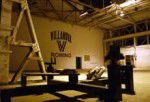Athletic department promises new boathouse.

February 13, 2004
Over a year after the women’s crew team nearly revolted because of unsafe and unsanitary facilities, the athletic department continues searching for a seven-figure donation to begin work on a new boathouse. Athletics Director Vince Nicastro estimated the entire project would cost between $4 and $5 million.
In a Nov. 22, 2002, article in The Villanovan, crew team members complained of dirty and broken windows, unreliable plumbing, a leaky ceiling, poor lighting and no heating. A few members also said the animal excrement throughout the boathouse caused blisters on their hands to become infected.
Following the complaints, the athletic department worked with the University to address the safety and health concerns raised about the current facility in Conshohocken. The renovations included installing heaters, revamping the only bathroom, repairing doors and windows and building a ramp from the storage warehouse to the river. Aesthetic improvements such as painting and raising a University crew banner were also made.
Nicastro estimated the improvements cost between $30,000 and $50,000. “We didn’t want to invest a lot because it is a temporary facility for us,” he said. “We made what we felt were the required [safety] corrections.”
Ann Mitchell, a senior captain and one of the most outspoken team members regarding the unsafe conditions, said, “The athletic department has taken great steps since I first got involved over a year ago.”
All renovations were completed in time for the team to return to the facility by the start of the Spring 2003 season.
Jack St. Clair, the team’s coach, agreed that the improvements turned the Conshohocken warehouse into an acceptable temporary practice facility.
However, “A new boathouse is long overdue,” St. Clair said. “I think the young ladies deserve it and I think the University deserves it.”
Mitchell said a new boathouse would put the crew team on equal footing with the University’s other varsity sports, most of which have safe, permanent facilities. Additionally, it would improve athlete recruiting and retention.
According to Nicastro, a lack of funding is the only thing holding the boathouse project back. “Right now we are in the process of identifying major donors who might be interested in coming up with a lead gift that would help get this project started,” he said.
“The University has made it clear that this project is one that needs to be funded from external sources, so there is not going to be any budget money [for the boathouse].”
Despite monetary issues, the athletics department has already begun work on other aspects of the project. Land in Conshohocken has been allocated for the new facility, and the University has begun obtaining building permits. St. Clair said this step could take between 10 and 18 months to complete. Additionally, the University has received proposals from three developers on various construction and financing options.
“[We want to] make sure this thing is going forward,” Nicastro said. “It’s on the front burner.”
Nicastro met with St. Clair and Steve Pinone, director of development for athletics, on Jan. 27 to identify major donors. Nicastro said the coach plays an invaluable role in fundraising because he knows individuals having a strong interest in women’s crew.
“I feel confident that we will be able to find donors,” St. Clair said, emphasizing such a large project will require more than one major donation. “I think there is a very good chance of us building a boathouse.”
The Athletic department ranked a new boathouse as its second most pressing facility need, behind an intramural recreation center / basketball practice center.
“I’m confident we’re going to get the boathouse done,” Nicastro said. “I’m not going to tell you it will be next week or a year from now or two years from now.”
Nicastro defended the decision to move to a temporary boathouse in Conshohocken because of the convenience factor. “Our intent for that facility was not to make it a boathouse; it was to store our boats and to make it convenient to the river from Villanova,” he said. “The alternative is to cart boats back and forth [from school] each morning.” The University once practiced out of Boathouse Row in Philadelphia, but with a facility so far away, students had trouble returning to campus in time for 8:30 classes.










